21 October 2015
PDF version [496KB]
Miranda Stewart
Professor and Director, TTPI
This paper is based on a Library Lecture given by Professor
Stewart on 21 October 2015.
Professor Stewart is a leading international expert on tax
law and policy, with more than 20 years’ experience. Miranda researches on tax
law and policy, including taxation of business entities in the context of
globalisation; not-for-profits; tax and development; budget laws and
institutions; and legitimacy of tax reform processes and institutions
nationally and internationally.
Recent books include (as co-editor or co-author) Not for
Profits Law; Death and Taxes and the textbook Income Taxation Commentary
and Materials and recent articles addressing the role of the Parliamentary
Budget Officer and issues of abuse and substance in multinational corporate tax.
|
ABSTRACT:
What is the purpose of tax
reform? And what, realistically, can tax reform achieve? This paper considers
the contemporary tax reform debate from a democratic, economic and social
perspective. Professor Stewart takes a long term view of today’s tax reform proposals,
and discusses the policy goals of sustainable revenues, economic prosperity,
fairness and resilience in Australia's tax system at federal and state
level.
|
Contents
An era of reform?
What is the purpose of taxes?
Tax and legitimate government
A century of income tax and democracy
Is there a crisis of the tax state?
Should tax reform fund the deficit?
What are principles of tax reform?
A tax reform goal for efficiency:
supporting economic prosperity?
Resilience
A tax mix ‘switch’ from income to
consumption?
Strengthening the GST
Strengthening the individual income
tax
Company tax, globalisation and
entrepreneurship
A tax system for the (medium term)
future
In the last few weeks, I have
spoken to a range of audiences about tax reform. They included Queensland and
Victorian tax specialists; State Departments of Treasury and Finance; students
of Global Finance; and the Prosper Society, formerly known as the Henry George
Society, who in the 19th century were known as the ‘single taxers’—land tax
being the single tax. Admittedly, most audiences have been tax specialists—or
tax enthusiasts—of one form or another.
I am not the only one speaking
about tax reform. Sometimes it seems that we talk of nothing else. The questions
are, ‘what are we seeking to achieve?’ and ‘what can we achieve?’ under this
label of ‘reform’.
I should say just a little bit
about where I have come from. I’ve been an academic for many years. I have
previously worked in private practice advising large corporations including
mining companies and also in the Australian Government working on business tax
policy and legislation. At the moment I am the Director of a fairly new
research policy institute at the Crawford School at ANU called The Tax &
Transfer Policy Institute.
In this role, I’ve been thinking
quite a lot about the system as a whole; if you like, trying to think
systemically.
I was invited, and very honoured
to be so, to the National Reform Summit that was held recently. Reform is like
sport. I love sport but I hate sports interviews, and I recall a cartoon whose
author escapes me, of a sports interview. The team captain says, ‘Well, we
sportsed very well out there that time, but unfortunately we didn’t sports well
enough. The other team sportsed better. So we’re going to go away and do some
training and we’ll be back to sports better next week’. We’ve been reforming
very hard. We haven’t reformed hard enough. If we go away and regroup we might
reform better next week.
There is a big challenge for
governments to communicate why they want to ‘reform’ and what it is. After the
Summit, I listened to 3SER Community Radio in Sydney, which is a young people’s
community radio, and they had their morning breakfast show where they talked
about ‘What happened yesterday?’ Well, it was the National Reform Summit, and
they said, ‘Yeah, so a whole lot of important people got together to talk about
reform. They thought there were a lot of things that needed reforming’—but they
did not understand what, why, or where the costs and benefits might arise.
One of the reasons the National
Reform Summit was held, was because there was a sense among a range of groups
that government itself was not pursuing reform. That may still be the case,
although there is now a little more momentum, I suggest, at the political level
including state and federal governments together, for some kind of a tax
‘reform’.
Before we think about the
purpose and expected effects of tax reform, what is the purpose of taxes?
Taxes are like plumbing. They
are not an end in themselves. Rather, they are a means to fund government,
resourcing joint, or public, action for the common good—rather than
individualised, private or market action. It is precisely because of social and
political organisation for the common good that we have taxation.
Adam Smith, writing 250 years
ago, asked why do we have taxes at all? Adam Smith is well-known as the father
of economics. It is less well known that he argued that government should be funded
by taxation. He said only taxes could provide ‘That sure, steady, and permanent
revenue which can alone give security and dignity to government ... for a great
nation’. Thus, taxes are needed for:
defraying the necessary expence of any great and civilized
state ... this expence must, the greater part of it, be defrayed by taxes of one
kind or another; the people contributing a part of their own private revenue in
order to make up a public revenue to the sovereign or commonwealth.[1]
Indeed, Adam Smith defined
political economy itself as being concerned with private and public revenue or
wealth:
Political œconomy, considered as a branch of the science of a
statesman or legislator, proposes two distinct objects: first, to provide a
plentiful revenue or subsistence for the people, or
more properly to enable them to provide such a revenue
or subsistence for themselves; and secondly, to supply the state or
commonwealth with a revenue sufficient for the public services. It proposes to enrich both the people and
the sovereign.[2]
Adam Smith had a vision for
funding government that was ahead of his time. In this context, he also
articulated a concept of ‘public goods’ which need to be funded with taxation.
The concept can probably be traced further back, certainly the general
conception of taxing to fund the benefit of government. However, Adam Smith
observed that there are public goods ‘in the highest degree advantageous to a
great society’ but which would not pay for any one individual to invest enough
and which should be provided for all.[3] For example, he included
education for children in this category: he considered that government should
pay for children’s education for the common good. This was inextricably linked
to his vision of a market economy, which would be viable in the longer term.
After 250 years, we are still
operating within that paradigm of the ‘tax state’, but legitimacy of government
through democratic institutions rather than inheritance or divine right has
become embedded. Political economic ideas about tax and politics (developed in
Britain, Europe and in the US) circulated widely including in Australia and
took hold early. The statement of the Eureka Stockade Rebellion in 1854 in
Victoria, which was put to the mining inspectors about the licence fees they
had to pay, said in its first paragraph:
That it is the inalienable right of every citizen to have a
voice in making the laws he is called upon to obey—that taxation without
representation is tyranny.[4]
In Australia, it is a
fundamental principle that the Parliament has supremacy in deciding the object,
shape, and weight of taxation. The High Court ruled on the progressivity of the
federal land tax in Osborne v Cth.[5] The Court held that it
is not for the Court to decide validity of a tax based on how oppressive or
steep the tax is. Barton J said:
Assuming that the taxation which it imposes is drastic, as it
is alleged to be, still it is not the function of the Court to say that drastic
taxation on landed interests will prevent residents from owning large areas, or
prevent landholders from residing out of Australia, or prevent absentees from
holding land within the Commonwealth. ... Even assuming that such designs
existed, they would not alter the construction of an Act or make it less an
exercise of the taxing power. They may be the motive or even the ultimate
object. We have not to do with either of these things. ... Conceding, for
example, that in some cases a heavy tax may when administered operate, by the
pressure of its severity, to destroy an industry which a State alone has power
to control, or to force holders of large landed estates to sell them, or to
remain in this country when they would rather live elsewhere, these are
questions of the policy or wisdom of the tax, and belong to the people,
directly or through their representatives, and not to the Court. And this is
true even if the tax is so heavy and so carefully adjusted as to appear
intended to produce the results foreboded. Questions of the abuse of power are
for the people and Parliament.
It’s important to remember, when
we’re thinking about trying to reform the tax system, that it is part of a
broader system of democratic government. If politics seems to get in the way,
we’re forgetting that politics is part of the point. Politics is actually why
we have taxes.
It is also important to remember
that the Constitution grants the Commonwealth Parliament power to levy any kind
of tax and that the Parliament has the capacity, through the grants and other
powers in the Constitution, to shape tax policy for the national good. At the
same time, our federal structure is embedded in the Constitution and it is
important for us to ensure that state and territory governments are fully
democratic, funded and accountable to their residents and taxpayers. The
importance of this has been highlighted recently by Cheryl Saunders and Michael
Crommelin; federation and tax reform should aim to strengthen our federal democracy.[6]
This year is the centenary of
Australia’s Commonwealth income tax. It was introduced in 1915 by Billy Hughes,
at that stage Attorney General under Prime Minister Fisher. The income tax was
an element in a suite of federal taxes that were enacted immediately before and
during World War I, including the land tax in 1912, estates duty in 1914 and
entertainments tax in 1916. Only the income tax has survived and it is under
scrutiny again in current tax policy debates, following the release in March
2015 by the Australian government of the Re:Think Discussion Paper,
aimed at a ‘national conversation’ on tax reform.[7]
When introduced, the income tax
was described by Sir Josiah Stamp, who was a leading economist in Europe, in a
somewhat ambiguous remark, as ‘A courageous effort by the Australian
Legislature’. The income tax was passed with bipartisan support, albeit this
was made easier because the Government, after a double dissolution, had a
majority in both Houses. The Leader of the Opposition, Mr Joseph Cook
(Parramatta), recognised how an ‘income tax’ is ’peculiarly appropriate in time
of war’. He was cautious about the longer term implications, observing that ’we
are, so to speak, blazing a track’ as the income tax ‘is, so far as the
Commonwealth is concerned, entirely novel, and of far-reaching importance.’[8]
However, all were not happy
about it. Mr W Elliot Johnson MP (Lang) presciently observed that ‘unfortunately,
there is all too much reason to believe that this taxation will not end with
the war’ and continued:
To me it seems only part of a
policy of frightfulness in taxation for which the war is made the excuse by
honourable members opposite.[9]
I have not heard the phrase ‘frightfulness
in taxation’ yet in our contemporary tax policy debate but before it comes to
an end I hope we see it resuscitated.
The federal income tax funded
the beginnings of the welfare state. By the 1950s, this welfare state was
well-established. You can see this trajectory in this chart from the Australian
Treasury of the last hundred years of tax in Australia from 1902 to 2013.
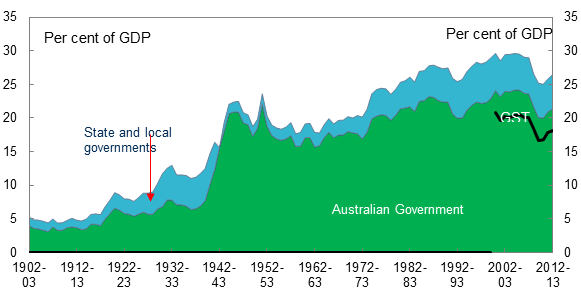
Australian
tax level, 1902-3 to 2012-13. Source: TTPI Stocktake Report, Chart 3.2; Treasury
data.
In this chart, you can also see
how small Australia’s government (at State and federal levels combined) was at
federation relative to the size of the economy: about 5 per cent of GDP. That
is smaller than the governments of most developing countries today. The chart
shows the expansion of government after World War II, from 1942 to the 1950s.
When our former Treasurer Joe Hockey said we have a tax system that looks like
the 1950s, as a matter of detailed law design this is inaccurate; but as a
matter of overall tax level and tax mix, it is generally correct. Nonetheless,
I have to wonder whether this is such a bad thing. In fact, we can see from the
chart that taxes (and spending) reached their peak under Prime Minister John
Howard during the 1990s, when revenues were pouring in regardless of what we
did. Tax and spending reached a peak and then crashed at the financial crisis
in 2009; are now on the way up again, but revenues have not recovered to
pre-crisis levels yet.
The Australian federal
individual and company income tax have come to provide the lion’s share of tax
revenues in Australia. At federation, income taxes—levied by the states—raised
only 6 per cent of Australian tax revenues. By 1939-40 this was 34 per cent,
but three quarters was still raised by the states. Today, the income tax is by
far our most important tax by revenue. Australia would look very different
without it.
In 2013-14, the personal income
tax, with the Fringe Benefits Tax and superannuation fund taxes, raised about
$173.7 billion, while company income tax (including petroleum resource rent
tax) raised $68.6 billion.[10] The total of $242
billion comprises 70 per cent of federal tax revenues, and is nearly six times
the revenues raised by the Goods and Services Tax. Income tax revenues are
enough to fund our cash transfer (social security and welfare) system, defence
and the federal government expenditure on health, in the current budget.
Commonwealth spending and the
Budget now is about one third social security and welfare (the transfer
system); one third health and education; and what’s called ‘other purposes’ is
the grants to the states, which really basically funds health and education.
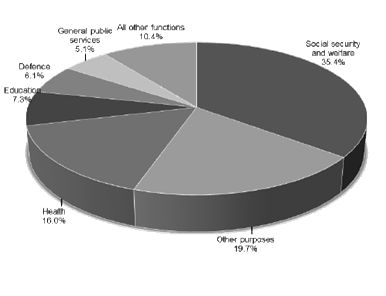
Commonwealth expenditures, 2014-15 Source: www.budget.gov.au
The chart below shows the
overall tax level as a percentage of GDP for several countries.[11]
For example, the Netherlands, UK, Spain, New Zealand, Canada and Japan, and the
OECD average, are higher than Australia. So we have a substantial collection of
tax but not massive. The chart also shows some of the different important taxes
including, of course, income tax. The tax state—the government that we have
constructed over the last century in Australia and in all these different
countries in different ways—relies most heavily on direct income tax and
consumption taxes.
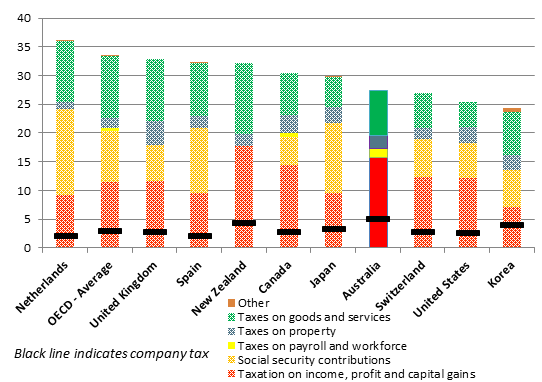
Australia’s tax level and tax
mix as % of GDP, comparative context; Source: TTPI Stocktake Report
(2015), OECD revenue statistics.
In conclusion, the income tax
has been very effective; with its growing revenue collection, together with
increased revenues from some other taxes, we have seen the growth of the public
sector in Australia. Nonetheless, this trajectory is visible across developed
countries, as is clear from the above chart and other OECD statistics; although
in some other countries the tax level is much higher than in Australia. There
is a real question as to where you would end up if you do change this dynamic
in Australia’s tax system.
At the very time that
Australia’s federal income tax became operational during World War I, Joseph Schumpeter,
the leading public economist from Austria (who then went to the US) articulated
the idea of the ‘tax state’: that is, a state that is developed and funded
dependent on taxation. It is interesting to consider Schumpeter’s views because
he is also one of the leading economic thinkers of the 20th century on issues
of entrepreneurship, innovation and the ‘creative destruction’ of markets; key
concerns that have again reached the political and economic agenda in Australia.
In 1917, Schumpeter was worried
about whether governments were going to be viable in the future and in
particular whether taxes were going to sustain them. He foresaw a fiscal crisis
of the state.[12]
What worried Schumpeter was that
he didn’t think taxes could sustain social expenditure. It wasn’t war or debt
that he was worried about, but funding what the people wanted the money to be
spent on: the social welfare state. Yet, our democratic government succeeded—after
many, slow and tortuous attempts especially through the Depression—in
mobilising tax revenues to fund the public services, goods and redistribution
that Australians wanted, as expressed through the democratic process.
In spite of the massive increase
in the size of government over the last century, we still don’t like paying
tax. We still have this extremely difficult politics of taxation. We celebrate
in Australia the rebel who avoids, resents and even steals from the state at
the same time as we celebrate our education health and welfare systems and the
equal opportunity and fair go that Australia has to offer—at least, to most of
its people, most of the time.
The federal government has a fiscal
deficit, as indicated in the 2015-16 Budget. The Budget projects that we will
recover a prudent stance of fiscal balance or a small surplus, without any
legislative change but as a result of the effect of bracket creep in the
personal income tax, by 2019-20.
Is this the right way to go? It
has been suggested recently that we should move away from this supposedly ‘volatile’
income tax base which goes up and down with recessions. But that is, in fact,
what the income tax is designed to do and one reason it is so resilient (I
return to the concept of resilience later). Collections fall in times of
recession and the government shares, to some extent, in the losses of
businesses and collects less from individuals who are earning less. Collections
go up in good times. And without indexation of income tax thresholds or
brackets (which Australia has never done, unlike Canada or the United States),
the progressive personal income tax grows with real wages and inflation, over
time fixing the deficit, while still collecting more from those who have higher
capacity to pay.
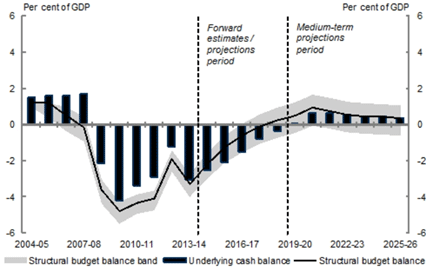
Source: Budget 2014-15, www.budget.gov.au
What does this mean for tax
reform? This may depend on your view about efficiency of taxation and a
different goal of tax reform being to support economic prosperity.
We could ‘fix the deficit’ by
leaving the income tax system, more or less, the way it is. Of course, even
doing nothing has distributional consequences. All Australians would contribute
to funding the deficit through bracket creep, but the effects may be felt more
strongly at low and middle income levels. In any event, leaving the system the
way it is will not deliver further revenues to fund apparently growing health
and other public expenditures in future; the government still projects
significant expenditure cuts being needed in the medium term.
We could—as has been suggested
by many—aim to raise other taxes, such as land tax, or the Goods and Services
Tax (GST) in order to increase tax revenues and fix the deficit. However, such
a change is rarely suggested as a simple addition to the current system.
Rather, it is usually argued that in making such a change, we should reduce
other taxes.
A tax reform that actually
raises taxes will require visible government benefits demanded by the people—and/or
a visible lowering of other taxes—if it is to garner sufficient support. Any
increase in some taxes and decrease in other taxes will also have
distributional consequences.
As taxes are a way to draw a
share of the economic return into the public domain, we clearly should care
first, about what is done with the funds—that the decision making about
expenditures is done in a fair way and funds are utilised for the common good—and
second, that taxes themselves are raised in the most efficient, fair and
effective way possible.
The classic tax policy
principles are equity (fairness), efficiency and simplicity. But probably most
people would agree that just raising a tax is not ‘reform’. It has to be
considered in light of the broader policy goals. On this basis, we have argued
at TTPI that taxes should be designed to produce sustainable revenues, while
supporting or helping deliver:
-
economic prosperity
-
fairness and
-
resilience.[13]
I’d like to read you a little
bit from Billy Hughes’ second reading speech for the 1915 income tax in which
the goals of fairness and prosperity are both discussed. To me it sounds like
this speech could be repeated today. What Hughes said was:
The Commonwealth has hitherto not resorted to taxation of
income but I have always regarded this form of direct taxation as particularly,
peculiarly appropriate to the circumstances of a moderate community. Not only
as an effective means for raising money for the conduct of government, but
serving as an instrument of social reform.[14]
That is the ‘ability to pay’
element which is a strength of our progressive income tax in delivering widely
recognised fairness to the tax system.[15] I value fairness highly
but in this lecture I want to focus on ideas of efficiency and resilience
of the tax system.
While we have a need for revenue,
when tax reforms have been done in Australia with the stated goal of increasing
prosperity, they have usually been presented as a ‘revenue-neutral’ package,
including substantial tax cuts and other compensation. That is more difficult
when we have a fiscal deficit stretching into the future.
It is interesting to note that
while supporting income tax as an instrument of social reform, Hughes was aware
in 1915 of the potential disincentives for economic activity of the income tax.
He continued:
It’s necessary to consider however not merely the requirements
of the revenue, but also the incidence of the tax so that the economic
equilibrium may be disturbed as little as possible. Australia is a very rich
country, her production per capita being very great, perhaps the greatest in
the world. A country’s productivity is the measure of its labour force, its
energy and its resources. The productivity of labour depends mainly on two
things, the amount of capital available and the manner in which it is being
used, and the efficiency of the labour. At this juncture it is of the utmost
importance that we shall do nothing to discourage enterprise.
Many are familiar with the
concept that tax ‘gets in the way’ of enterprise or productive market activity
and that efficiency requires a neutral and lowest possible tax. This is the
basic model that economists use about efficiency of a tax. You impose a tax on
a good (this is your pre-tax world); in the post-tax world, the supply goes
down and the price goes up. Some of the tax goes to government; that’s the
wedge. So taxes impose a wedge between demand and supply. Vendors get less,
buyers pay more, the difference is the tax, and that triangle in the middle is
what is called the deadweight loss because the quantity produced overall
declines.
One of the key elements of
economic thinking is that it aims to optimise supply using price in the
market: to come to the single most efficient method for doing something, the
optimal allocation of resources.
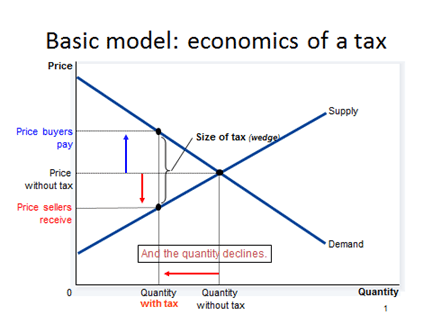
The Treasury argues that the
economic costs of the tax system (the ‘marginal excess burden’) are higher than
they need to be and that many features of the existing system make it less
attractive to invest in Australia and limit job growth, affect work incentives
or add significant complexity across the system. For particular taxes, Treasury
estimates that stamp duty on transactions and insurance are the least efficient
followed by company income tax; that a broad based land tax (and council rates)
on land value are the most efficient; and that a broad based flat rate GST and
flat rate income tax have equivalent efficiency.
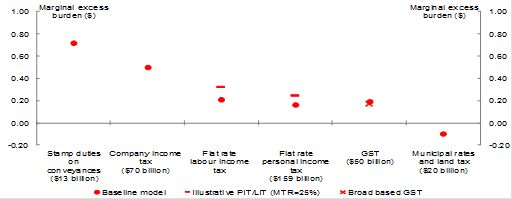
Marginal excess burden of major Australian taxes. Source:
Australian Government, Treasury Working Paper 2015/1 (April 2015), Chart
33, www.treasury.gov.au/PublicationsAndMedia/Publications/2015/working-paper-2015-01
The Treasury explains carefully
the many assumptions in its modelling. The model depends on assumptions about
responsiveness of work, investment and savings to taxation, of rational
behaviour with full information and few if any market constraints; however,
those assumptions may not reflect actual behaviour and it is important to
consider empirical evidence. The model also assumes households act as a single
unit and does not identify individual earners in a family and their incentives
or responses to tax systems. Individuals may also respond to taxes in ways that
seek to reduce their tax bill—through tax planning—without changing their
underlying economic behaviour.
Yet even acknowledging these
limitations, it would be wrong to ignore the potential behavioural effects of
taxes and broader economic costs of those responses, as empirical evidence does
show that statistically, individuals do respond in various ways to features of
the tax system and that tax rates—and concessions or loopholes in the system—can
have real effects on economic behaviour.
We can think about the tax
system as a system that connects public and private revenues across the economy
(in Adam Smith’s language)—or connects government to individuals and businesses
and creates relationships between individuals through collective decision
making about resource allocation. I’m interested in a resilient tax system
because I’m interested in a stable democratic government.
In applying a concept of
resilience to our tax and transfer system, I adapt the approach developed by
scientist Brian Walker for consideration of sociological and ecological
systems.[16] The concept of
resilience has also come to the fore in a financial context after the global
financial crisis, regarding ‘resilience’ of the financial and banking system
globally and of national markets such as housing markets.
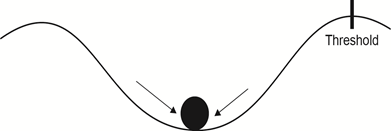
System resilience. Source: www.stockholmresilience.org/21/research/what-is-resilience.html
Systems theory suggests that
resilience is about the capacity of a system to recover its equilibrium. As
illustrated by the figure above, systems theorists use the metaphor of a ball
in the bowl; that the world changes, there are shocks and crises and so on, but
unless you hit that threshold you’ll bounce back, the system will more or less recover
to its equilibrium. However, once over the threshold, the system is destroyed
and a new equilibrium may be established.
In the ecological context,
systems resilience is used to talk about ecosystems that are pushed over a
threshold and can never recover their previous state. Salinity in the soil is
an example: you get to a certain threshold of salinity in the soil, it gets to
within two metres of the surface, and then it changes the ecosystem and there’s
no return. So this idea of being able to recover, or, alternatively, to
transition safely to a new equilibrium is central.
In contrast to the economic goal
of optimisation, resilience may require some diversity or redundancy of methods
or approaches in the system. A key element of resilience thinking is to observe
that fully optimising a system may make it less resilient. We should expect,
therefore, that we may not be able to fully optimise the system, in part
because we cannot predict which elements of the system may collapse or fail, so
retaining a variety of elements in the system is important.
If we think about tax system
resilience, what might be some of the features we want our system to have? We
want it to be resistant to planning, we want it to have low costs for
sustainable revenues, and we want it to be adaptable to future challenges. That
also means the system must be politically legitimate and sustainable.
For example, integrity rules in
tax systems are necessary to ensure resilience although they frequently
introduce complexity and cost. We may aim for simplicity and efficiency in
taxation by moving to reliance on only one or a few ‘ideal’ taxes. But having several
different taxes applying to different bases in the system—but not too many—may
lead to a more resilient system in the long term, even if the different taxes
do not themselves raise much revenue.
Some kinds of change in our tax
system may be difficult to reverse or modify in future, and this could undermine
efficiency, fairness and resilience. A historical example in our tax system of
a shift over a threshold to a new equilibrium may be the abolition of
inheritance taxes by all states and by the federal government in the late 1970s
up to 1981. In spite of increased attention being paid to wealth taxes today as
a useful policy instrument and efficient tax, moving (back, or forward) towards
higher wealth taxation is extremely challenging politically. We seem to be in a
stable state in which we under-tax wealth and assets, in an era when there is increasing
concern both about inequality and about efficiency of taxation.
There are other reasons why our
tax system may be becoming less resilient, especially regarding mobility of
capital; increasing digital or intangible value creation; and changes in the
way in which we all work.
One efficiency argument commonly
made is that Australia needs a tax mix ‘switch’ away from income tax and
towards consumption. A cut in less efficient taxes could be funded by an
increase in other taxes—or by base broadening of more efficient taxes. The idea
of a tax mix ‘switch’ away from personal income tax towards the GST is commonly
floated. Premier Mike Baird of NSW recently proposed an increased GST although
most of the revenue would be distributed to the states, on his proposal, rather
than being used up in personal income tax cuts.[17]
Such a tax mix ‘switch’ could be
achievable politically because both GST and personal income tax are in the
federal tax base, so that both tax and compensation could be delivered by the
same government—even though by agreement, we allocate all GST revenues to the states.
However, the narrative that this
would generate a large efficiency gain is misguided if the focus for the ‘switch’
is on individual income tax.
The Treasury modelling set out
above shows that at a flat rate, efficiency of personal income tax and (broad
based) GST is basically the same. The model assumes the GST in such a
comparison is broad-based, which our GST is not, as it applies to less than
half of the potential consumption base.
The model also assumes, as
mentioned, that a household acts as a single unit, when in fact it is critical
to observe that households have two earners who work and invest in different
ways—who operate as different taxpayers. This assumption is often made because
it is easier to collect data on a household basis; and in particular, it is
difficult to unpack consumption within a household.
Measures of efficiency that take
women’s workforce participation seriously and use an individual base—and this
is a key element of our workforce that is underutilised and a key platform in a
prosperity agenda—indicate that a progressive personal income tax is
most efficient.[18] It taxes lower waged and
more responsive workers (whose choice to work is more ‘elastic’) at a lower
rate, and those with higher wages—who have, empirically, lower ‘elasticity’ of work
response—at a higher rate. That is consistent with goals of economic efficiency
and women’s workforce participation.
Consequently, a straightforward tax
mix ‘switch’ between GST and personal income tax may not have a substantial positive
effect on the economy. It could even be counter-productive. It will not address
those taxes where the economic argument has the most weight—which are state
land tax and payroll tax.[19] It may also reduce
resilience of our tax system in the longer term, on the basis of fairness and
legitimacy of the tax.
Such a tax mix ‘switch’ may also
fail to address other weaknesses in our tax system. For example, in the state
tax bases, we have local government taxes, stamp duties and land tax (among
others). Professor John Freebairn and I have recently done a report that
reiterates the economic arguments for doing a switch between land tax and stamp
duty, pushing that land tax share of the burden up and taking it off
transactions and appreciated property values.[20] Australia has a
relatively low reliance on property taxes overall in our whole tax mix—lower
than in comparable countries and we could improve that.
The GST raises only about one
fifth of income tax revenues. It is reasonably effective, but the Australian
Tax Office faces more problems with debt collection and the informal economy in
the GST area than in most other areas of tax collection. The GST has the
highest administrative cost of collection and also the highest compliance costs
especially from small business.[21]
These are reasons to reform GST.
There is a more general ‘resilience’ argument for why our indirect tax base
(mostly the GST) needs to be strengthened, including, perhaps, broadening the
base, as well as an efficiency argument. Australia’s indirect tax base is
eroding. As a share of GDP and overall tax revenues, Commonwealth indirect
taxes have actually declined since the mid-1980s.[22]
Broadening the GST base and—to a
limited extent—raising the rate, can strengthen the indirect tax base. We
should, to support resilience of the system, aim to increase our indirect tax
base in particular through strengthening the GST base and perhaps by
strengthening other indirect taxes—such as a carbon tax, fuel excise, or taxes
on alcohol or specific goods (even, perhaps, sugar).
What about efficiency and
resilience of the individual income tax? In our current system, we know that
our income tax applies to people’s wages—although not as heavily as many
countries—but it also applies very unevenly to the return to saving and
investment.
I have discussed bracket creep
above. The chart below from the Re:think Discussion Paper (updating the
Murray Financial Systems Inquiry report of 2014) shows the effective income tax
rates on different forms of investment or saving in our personal income tax.
The chart shows effective tax rates for a person on the 32.5 per cent marginal
rate. The bank account is taxed at their marginal rate. Their own home faces
zero tax. Although we call it an income tax, we actually have a hybrid
income/consumption tax that produces expenditure tax treatment of home
ownership, a zero tax rate, or what we sometimes call a ‘pre-paid’ expenditure
tax. Other real estate is taxed but not as heavily because of the capital gains
tax (CGT) discount. The chart does not take account of negative gearing.
Superannuation, overall is more generous even than expenditure tax treatment
and that generosity goes to the top end. Australian and foreign shares are
taxed differently at lower rates.
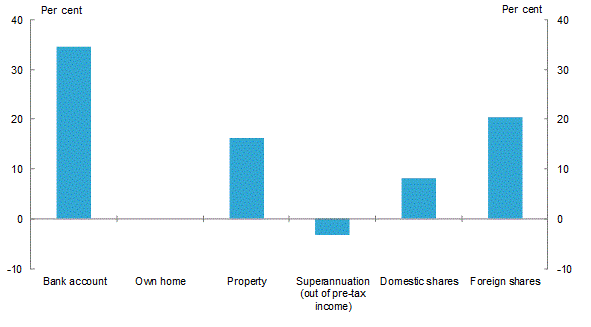
Effective tax rates on different forms of saving (32.5%
marginal rate)
Source: Australian Government, 2015 Re:think Discussion Paper, http://bettertax.gov.au/publications/discussion-paper/
.
A key concern about resilience—and
efficiency—of our personal income tax is this unevenness. This has been raised
in policy documents for a long time. Associated with that, I do think that
negative gearing of real estate is a problem. As shown in the chart below, ATO
tax statistics show very large net rental losses (net rent is the red line, net
of all deductible expenses). These large deductible losses in our income tax
are undermining the wage tax base, and are actually operating as a tax shelter.
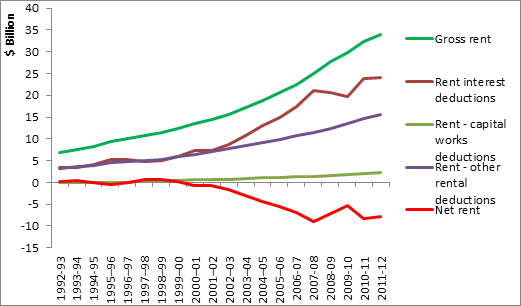
Net rental losses. Source: Australian Tax Office
Statistics 2012-13.
The moderate income earner, for
example, a hairdresser who buys a rental investment property with debt under $400,000,
is not going to make a large capital gain (certainly not in the short term). So
really what they’re doing is buying a tax shelter when they invest in rental
real estate. From a tax reform perspective, one thing that we need to keep
working on is this coherent treatment of taxation of savings. This would
support efficiency and resilience of the system.
The company income tax is
considered by the Australian Treasury as a less efficient tax: it is modelled
as being nearly as inefficient as stamp duties, as indicated in the Chart above.
At a 30 per cent rate since 2000 (now 28.5 per cent for small companies),
Australia company tax is argued to be uncompetitive with other countries.
Treasury modelling suggests that in a world of mobile capital, the tax rate
should be lowered. The argument is that it discourages the marginal foreign investment
that Australia needs.
Yet, our company tax is an
effective revenue raiser. That the bulk of our $68 billion in company tax
revenues are collected from the largest 20 companies, on the whole reflects
that it is doing its job. Australia’s now almost unique dividend imputation
system means that Australian resident companies with Australian shareholders
(including superannuation funds) have a strong incentive to pay Australian tax.
Imputation credits on franked dividends return nearly half of company tax revenues
collected to shareholders. Some of the remaining company tax is on reinvested
profits and some of it is effectively borne by non-resident investors, who do
not pay dividend withholding tax but do not get the benefit of imputation
credits either.
The company tax performs a
multitude of functions. In our resource economy (unlike, for example, the
United Kingdom), the company tax collects a lot of revenue from resource
extraction. The company tax also acts as a 'backstop’ for personal income tax,
although because the company tax rate is a lot lower than the top marginal
rate, tax planning incentives still exist and high wealth individuals have
capacity to cap their tax rate at either the discount capital gains tax rate or
the company tax rate.
The effective collection of
resource revenues does make our company tax collections vulnerable to declining
commodity prices. Company tax is also under challenge from economic
globalisation. The OECD have just released their final reports, to which
countries agreed by consensus, of ways that the international tax regime can be
cooperatively changed to address ‘base erosion and profit shifting’ (or BEPS).[23]
The G20 Finance Ministers endorsed these and we will likely see some action in
coming years. Australia has already tightened our thin capitalisation debt
rules and has introduced a ‘multinational anti-avoidance law’ which seeks to
tax large businesses (such as Google) selling into Australia without having a
taxable business presence. These processes will support the company income tax
base.
However, even these cooperative
solutions will not address the potential for real economic investment to move
in response to tax competition. In the longer term, this raises big questions
about the future of the company tax in a global context. However, in the short
term, while our company tax rate potentially could come down a little—at a
revenue cost that would have to be made up elsewhere—I would not like to see us
dramatically cut the company income tax rate without significant and careful
consideration.
What of Prime Minister Turnbull’s
agenda for innovation and entrepreneurship? This builds on the focus of the Government
in the last couple of years which has emphasised tax as a barrier to small
business and the role of taxation concessions in encouraging and supporting
small business. As indicated by Hughes speech in 1915, concerns about the
impact of income tax in deterring enterprise or investment have a long history.
Nonetheless, we should be
cautious about enacting special rates, tax exemptions, credits or deductions
targeted at particular kinds of investment. First, we need to be clear what the
goal is. Small businesses play a very important role, but most of them do not
grow or contribute in a significant way to economic growth. Some, but not most,
new businesses, innovate and grow; many stay the same size, do not innovate
much, while many fail. Second, businesses or investors may not respond to tax
incentives (for example, Australia’s first attempt to encourage foreign pension
funds to invest in venture capital in this country basically had no effect).
Third, if businesses and investors do respond to tax incentives, the way in
which they respond may be unpredictable and we can rarely identify if there is
substantially increased real investment or gains on the margin. Fourth, we
already provide a lower tax on capital gains—potentially too generous—through
the CGT fifty per cent discount and through exemptions in venture capital funds
vehicles.
We pay a significant price for
creating ‘Swiss cheese’[24] of our company income
tax (and the personal income tax), through increased complexity, administrative
costs and tax planning. Finally, it must be remembered that other economic and
social drivers for innovation and entrepreneurship—for example, public
expenditure on education or legal entity forms, wages and other taxes, may have
more effect than income tax.
The goals of tax reform depend
largely on the time horizon. What should the tax system look like in two or
five years’ time? What about in 10 years’ time? In 2055? (the 40 year time
horizon for the Intergenerational Report[25]).
As we look to the future, we
should be actively working on building a resilient tax system that is simple
and transparent for taxpayers and low cost for administrators. Digital ‘disruption’
is not only a negative for the tax system. For example, we could aim, by 2025, for
every individual to have a ‘single touch’ digital tax account that tracks their
tax paid, expenses in real time and does away fully with the requirement for a
tax return. Any reconciliation could be electronically calculated and refunds
paid at year end. Employer Pay-As-You-Go wage tax withholding, and
superannuation guarantee, would continue but would be updated and linked to
this personal tax account—as we increasingly work more flexibly and with
multiple employers and sources of income in future. A more uniform and broad
based system would be simpler to administer through a single digital account.
We should be able to collect
taxes for both federal and state governments from the same platform—payroll
tax, for example, on the PAYG base and land tax on the council rates base. To
address globalisation and mobility of investment, tax administrators need to be
nationally and globally networked, while retaining confidence of taxpayers that
privacy will be protected and the systems are procedurally fair. If we can
build this capacity, then we can more easily move to harmonised tax bases on
wages, consumption and land across governments for the national good.
In the longer term, there are
many unpredictable elements because of technological change.
For example, in two decades, some suggest that 40 per cent of existing jobs in
Australia may have disappeared because of changes such as automated driving.[26]
What might this mean for tax reform? First, we don’t want taxation to get in the
way of job creation—we do really need to manage economic change and find
meaningful work and livelihoods for current and future workers. Second, we want
a tax system that can continue to raise a fair share of revenues for government
from the many, diverse, and flexible ways in which individuals derive economic
return in future.
We’ve had a lot of change in our
tax and welfare systems since the 1950s: globalisation of the economy; massive
migration; urbanisation and development of our cities; the feminist revolution
that brought women in massive numbers into our education, work and economic
systems; and now a transition to longer lived but overall, ageing population
and new technologies. The tax system has on the whole, through these dramatic
changes, shown resilience and recovered to a stable state that is based at its
core on an income tax. We have a dynamic political economy; as needs change,
our tax and spending systems can change too. Tax reform is not a ‘once and for
all’ process but an ongoing responsibility of the Parliament in legislating for
the common good of all Australians.
[1] Smith, A. (1776) An
Inquiry into the Nature and Causes of Wealth of Nations, Book V.2.13,
V.2.22. available in full text from www.econlib.org
[2] Ibid., Book IV.I.1.
[3] Ibid., Book V.1.69.
[4] Ballarat Reform League
Charter (1854), ratified by the miners of Ballarat at Bakery Hill, 11 November
1854, available from http://wiki.prov.vic.gov.au/index.php/Eureka_Stockade:Ballarat_Reform_League_Charter
[5] [1911] HCA 19; (1911) 12
CLR 321
[6] Saunders, C. and Crommelin,
M. (2015) ‘Reforming Australia’s Federal Democracy’, Melbourne University Law
School Legal Studies Research Paper No. 711 and see www.themandarin.com.au/44286-ten-principles-reform-federation/?pgnc=1
[7] Australian
Government (2015), Re:Think Tax Discussion Paper (March 2015), available
from www.bettertax.gov.au
[8] Commonwealth Parliament, Hansard, House of
Representatives, 31 August 1915, p. 6373.
[9] Commonwealth Parliament,
Hansard, House of Representatives, 31 August 1915, p. 6409.
[10] Australian Government, Budget
2015-16, Paper No. 1, Statement 5 (Revenue), Table 7.
[11] This chart excludes
superannuation (as it is not treated as a tax).
[12] Schumpeter J A, 1918,
1954, ‘The Crisis of the Tax State’ in R Musgrave and A Peacock (eds), Classics
in the Theory of Public Finance (New York, Palgrave MacMillan), p. 101.
[13] Stewart, M. et al (2015) Stocktake
Report (Tax and Transfer Policy Institute, ANU) available from https://taxpolicy.crawford.anu.edu.au/files/uploads/taxstudies_crawford_anu_edu_au/2015-03/stocktake_report_final_web_version.pdf
[14] Commonwealth Parliament, Hansard, House of Representatives, 18 August 1915, p. 5843-4.
[15] Ibid.
[16] Walker,
B. and Salt, D. (2006) Resilience Thinking: Sustaining Ecosystems and People
in a Changing World (Island Press).
[17] Nichols, S. ‘NSW Premier
Mike Baird calls for GST to rise to 15 per cent’ Sydney Morning Herald, July
20, 2015, available from www.smh.com.au/nsw/nsw-premier-mike-baird-calls-for-gst-to-rise-to-15-per-cent-20150719-gifxcm.html
[18] See Andrienko, Y., Apps, P., Rees, R. (2015). Gender Bias in Tax
Systems Based on Household
Income
[19] See www.theage.com.au/comment/five-ways-to-make-state-taxes-fairer-and-more-efficient-20150922-gjs5dt.html;
and J Freebairn, M Stewart and P Liu Reform of State Taxes in Australia:
Rationale and Options (2015) available from http://government.unimelb.edu.au/renewing-federalism
[20] Ibid.
[21] See ATO,
Annual Report 2013-14, available from www.ato.gov.au
[22] As shown in 2015 Budget
Paper No 1 revenue tables, analysed by Greg Smith, Back to the Future,
TTPI Conference on the GST in the Real World, 26 August 2015, available
for download from https://taxpolicy.crawford.anu.edu.au/news-events/events/6046/future-australias-gst-good-design-real-world?tb=download#tab
[23] OECD, Base Erosion and
Profit Shifting (BEPS) Project, endorsed by G20 Finance Ministers on 9 October
2015, www.oecd.org/g20/topics/taxation/g20-finance-ministers-endorse-reforms-to-the-international-tax-system-for-curbing-avoidance-by-multinational-enterprises.htm
[24] In the words of economist
Saul Eslake, www.sbs.com.au/news/article/2015/09/22/tax-system-swiss-cheese-rich
(22 September 2015)
[25] Treasury, Intergenerational
Report 2015, www.challengeofchange.gov.au/TheIGR/
[26] CEDA (2015), Australia’s
future workforce?, available from http://www.ceda.com.au/research-and-policy/policy-priorities/workforce
.
|
This paper has been provided by a presenter in the
Parliamentary Library’s Seminar and Lecture Series. The views expressed do
not reflect an official position of the Parliamentary Library.
The copyright remains with the original author and
permission may be required to reuse the material.
|